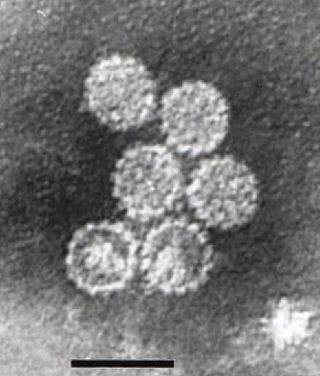
Papillomaviridae is a family of non-enveloped DNA viruses whose members are known as papillomaviruses. Several hundred species of papillomaviruses, traditionally referred to as "types", have been identified infecting all carefully inspected mammals, but also other vertebrates such as birds, snakes, turtles and fish. Infection by most papillomavirus types, depending on the type, is either asymptomatic or causes small benign tumors, known as papillomas or warts. Papillomas caused by some types, however, such as human papillomaviruses 16 and 18, carry a risk of becoming cancerous.
Rhadinovirus is a genus of viruses in the order Herpesvirales, in the family Herpesviridae, in the subfamily Gammaherpesvirinae. Humans and other mammals serve as natural hosts. There are 12 species in this genus. Diseases associated with this genus include: Kaposi's sarcoma, primary effusion lymphoma and multicentric Castleman's disease, caused by Human gammaherpesvirus 8 (HHV-8), also known as Kaposi's sarcoma-associated herpesvirus (KSHV). The term rhadino comes from the Latin fragile, referring to the tendency of the viral genome to break apart when it is isolated.

Lymphocryptovirus is a genus of viruses in the order Herpesvirales, in the family Herpesviridae, in the subfamily Gammaherpesvirinae. This genus includes the human-infecting Human gammaherpesvirus 4, as well as viruses that infect both Old World monkeys and New World monkeys. Other names for the Lymphocryptovirus genus include Lymphocryptoviridae and gamma-1 herpesviruses. There are nine species in this genus. Diseases associated with this genus include: mononucleosis, Burkitt's lymphoma, and nasopharyngeal carcinoma.

Orthohepadnavirus is a genus of viruses, in the family Hepadnaviridae. Humans and other mammals serve as natural hosts. There are 12 species in this genus. Diseases associated with this genus include: hepatitis, hepatocellular carcinoma, and cirrhosis.
Betapapillomavirus is a genus of viruses in the family Papillomaviridae. Human serve as natural hosts. There are six species in this genus. Diseases associated with this genus include warts, papillomas, and malignant tumours.
Deltapapillomavirus is a genus of viruses in the family Papillomaviridae. Ruminants serve as natural hosts. There are seven species in this genus. Diseases associated with this genus include: warts of the skin and alimentary tract ; possibly responsible for the skin tumour equine sarcoid in horses and donkeys.
Epsilonpapillomavirus is a genus of viruses in the family Papillomaviridae. Cattle serve as the natural hosts of these bovine papillomaviruses. There are two species in this genus. Diseases associated with this genus include fibropapillomas and true epithelial papillomas of the skin.
Etapapillomavirus is a genus of viruses in the family Papillomaviridae. Birds serve as natural hosts. There is only one species in this genus: Etapapillomavirus 1. Diseases associated with this genus include cutaneous lesions.
Gammabaculovirus is a genus of viruses, in the family Baculoviridae. Hymenoptera serve as natural hosts. There are two species in this genus.
Gammapapillomavirus is a genus of viruses in the family Papillomaviridae. Human serve as their natural hosts. There are 27 species in this genus. Diseases associated with this genus include warts and papillomas.
Iotapapillomavirus is a genus of viruses in the family Papillomaviridae. Rodents serve as natural hosts. There are two species in this genus. Diseases associated with this genus include cutaneous lesions and benign skin tumours, such as papillomas and keratoacanthomas.
Kappapapillomavirus is a genus of viruses in the family Papillomaviridae. Rabbits serve as natural hosts. There are two species in this genus. Diseases associated with this genus include cutaneous and mucosal lesions.
Lambdapapillomavirus is a genus of viruses in the family Papillomaviridae. Cats and dogs serve as natural hosts. There are five species in this genus. Diseases associated with this genus include mucosal and cutaneous lesions.
Mupapillomavirus is a genus of viruses in the family Papillomaviridae. Humans serve as natural hosts. There are three species in this genus. Diseases associated with this genus include palmoplantar warts.
Nupapillomavirus is a genus of viruses in the family Papillomaviridae. Humans serve as natural hosts. There is only one species in this genus: Nupapillomavirus 1. Diseases associated with this genus include facial warts. This virus has also been detected in some skin carcinomas and premalignant keratoses.
Omikronpapillomavirus is a genus of viruses in the family Papillomaviridae. Porpoises serve as natural hosts. There is only one species in this genus: Omikronpapillomavirus 1. Diseases associated with this genus include genital warts.
Pipapillomavirus is a genus of viruses in the family Papillomaviridae. Hamsters serve as natural hosts. There are two species in this genus. Diseases associated with this genus include cutaneous lesions.
Thetapapillomavirus is a genus of viruses in the family Papillomaviridae. Birds serve as natural hosts. There is only one species in this genus: Thetapapillomavirus 1. Diseases associated with this genus include cutaneous lesions.
Xipapillomavirus is a genus of viruses in the family Papillomaviridae. Bovines serve as natural hosts. There are five species in this genus. Diseases associated with this genus include true papillomas on the cutaneous or mucosal surfaces of cattle.
Zetapapillomavirus is a genus of viruses in the family Papillomaviridae. Horses serve as natural hosts. There is only one species in this genus: Zetapapillomavirus 1. Diseases associated with this genus include cutaneous lesions.


